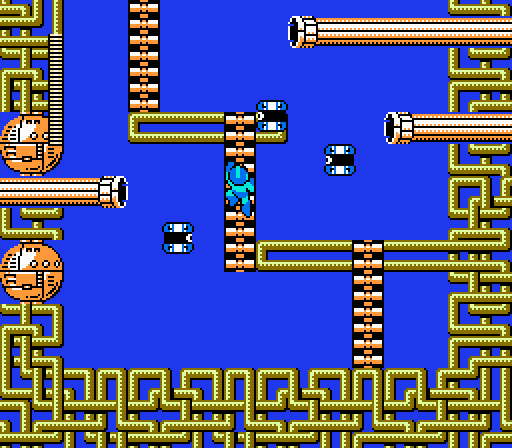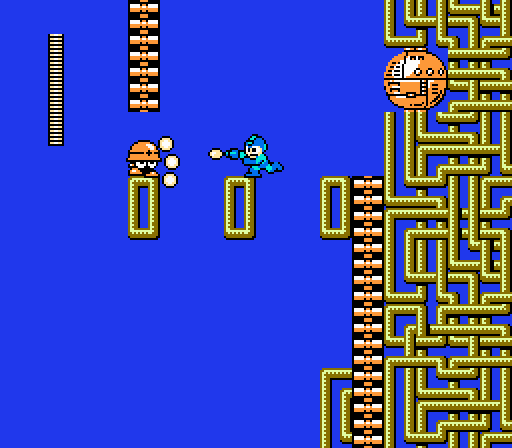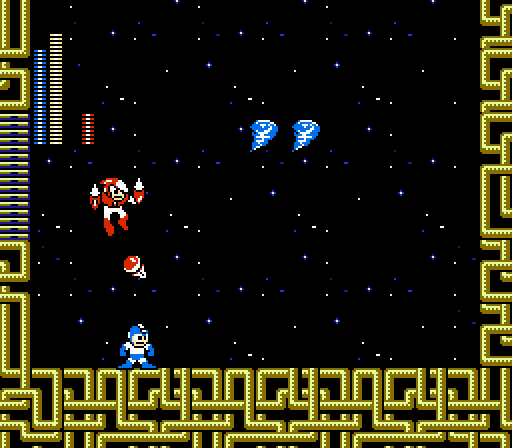And finally — last and least — it’s Crash Man’s stage. Or Clash Man. Or Crush Man. There was some confusion back in the day.
Maybe “least” isn’t entirely fair; it’s not an awful stage in terms of layout or mechanics by any means. However, it’s by far the most visually unexciting level in the entirety of Mega Man 2, consisting entirely of a tangle of mustard-yellow pipes punctuated by larger orange pipes and what appear to be boilers. It just feels very flat and repetitive.
It’s also not a particularly friendly stage with which to make your entrée into the game’s cycle. It’s by far the most vertical stage in the game, even more so than Elec Man’s stage was in the original Mega Man. And, unlike in Elec Man’s level, most of the hazards you encounter here appear toward the top of the screen rather than confronting you on your own level. Since Mega Man can’t fire upward by default, this makes for something of a dangerous scenario if all you have to rely on is the P shooter.
You’ll get a taste of this dynamic in the very first screen: You begin at the bottom of the screen with a cascade of ladders to climb. Meanwhile, the Tellies that spawn throughout Heat Man’s stage pour infinitely from the larger conduits flanking the screen. Up to three can appear on screen at a time, and as soon as you gun down one another appears.
This is one of the few stages in which the Air Shooter proves to be incredibly valuable — its upward motion and wide spread can clear big swaths of enemies as you ascend. And that’s fitting, because Air Shooter just absolutely annihilates Crash Man. Mega Man 2 once again nudges you toward the boss weakness through the design of the stage… in fact, this may well be the best example of this design philosophy we’ve seen to date.
Alas that it’s somewhat undermined by, yes, the Metal Blade. With its low cost, 8-directional targeting, and high stopping power, the Metal Blade actually works slightly better than the Air Shooter here. Metal Blade, you ruin everything.

The other weapon that comes in super handy as you advance on Crash Man? Leaf Shield. It’s useless against the Robot Master himself (the explosive effect of the Crash Bomber being good against Wood Man, not the other way around), but several scenarios here make the Leaf Shield surprisingly effective. These rail-based platforms send you zigging all around the screen at high speeds while flocks of Tellies mill about. You can gun them down, sure, but the easiest thing to do here is simply stand still as the Leaf Shield annihilates everything in your sinuous path. You can’t move under your own locomotion while using the Shield… but you can move under some other device’s steam. Even better, the enemies you pop while skidding around are pretty likely to drop energy refills that will drop in your path, so you’ll come out ahead.
The stage offers a few tricky platforming sequences, with mildly annoying but not really frustrating penalties. This little spot in particular is a nice little puzzle. The Metool here sits in your way, but you can’t shoot it from a distance; it defends itself until you come near, at which point it pops open and fires at you. Its response threshold works out to be right about where you land on the middle platform, giving you a tiny window of opportunity to fire at it before it shoots bullets that are almost guaranteed to hit you. The knock back will send you skidding off the platform to drop into the pit below… but thankfully, that simply sends you back a screen to climb again. It’s a nuisance, but at least it’s not an instant kill. A chance to master a deliberately tricky sequence with a modest punishment for failure that gives you incentive to sort it out without being nasty about it.
The one nice visual effect of this stage is that the background transitions from day to night as you ascend. The blue sky deepens; then it turns pitch black; then stars begin to twinkle in the background.
The second part of the stage mostly consists of a lengthy climb up multiple screens. It’s very Snake Eater, except here you have to contend with enemy attacks as you climb. Those gun dudes from Flash Man’s stage pelt you with bullets, while the birds fly past and drop eggs that explode into a swarm of chicks.
The enemies here aren’t particularly dangerous, but as with the Metool they can be very annoying. If Mega Man suffers damage while climbing, he’ll lose his grip and plummet a screen or three. So while you probably won’t die in this area, chances are good that unless you play cautiously you’ll be forced to retrace your steps repeatedly.
At the very top, you’ll finally hit an expanse of horizontal ground that spans more than a screen or two. It’s patrolled by the propeller guys from Heat Man’s stage, who much like the Tellies before will continue to spawn infinitely. And as with the Tellies, Air Shooter works wonders here… but Metal Blade is even better. Ho hum.
As for Crash Man himself, he can be extremely difficult to defeat without the Air Shooter. With the Air Shooter, he’s a cinch; he leaps about the room, putting himself directly in the path of the weapon’s projectiles, and a mere three shots will take him out. Without the correct weapon, though, his aggressive movements, hurtling jumps, and deadly projectiles can prove tough to counter.
The Crash Bomber works a little differently when used by its proper owner than when players control it. While Mega Man can only fire the projectile straight ahead, Crash Man can fire it freely at any angle. He tends to target it toward Mega Man’s feet so that the projectile itself will pierce Mega Man, then clamp onto the ground and explode. The resulting explosion comes with just an extensive residual blast effect that it can easily score two hits against Mega Man… and given how powerfully it hits, that can make for a short battle indeed.
All in all, a stage that plays more interestingly than it looks. But you probably don’t want to tackle it first.





I remember when I first played it, I wasn’t sure whether the stage was demonstrating a day to night transition, or if it was trying to imply that Mega Man was climbing really high.
I think things remain the same once they’ve changed when you climb back down, but I’m not positive.
Oh. If I remember, the effect reverses when you climb down. So yeah, it’s probably meant to imply that Crash Man’s inexplicable tube tower rises into the sky.
You have to play for a while before you realize it, but Crash Man is one of the easiest bosses in the game with just the buster. Like Metal Man, he’s reactionary. He won’t attack unless you do it first, so if you pace the room just like him, then jump and shoot when you draw close, he’ll leap right into your shot, and by the time you reach the other side and turn around, his crash bombs will have finished going off. Basically, pretend to be Crash Man and he’ll go down like a chump.
Yeah. While I’m not a fan of Crash Man’s level, I think the boss battle might actually be my favorite in the entire series, because of how much it rewards careful observation and understanding of his attack pattern. When you first see him, he seems to be about as difficult and unpredictable as Quick Man, and what’s more, he seems to have an uncanny ability to predict when you’re going to shoot at him and dodge out of the way. But when you know the trick to fighting him, you can not only predict his movements, but actually control them to a fair degree, and when you’ve figured it out, he’s barely any harder than Bomb Man. (And if you play a lot of classic games, not only will you see the exact same trick in use with later Robot Masters like Gemini Man and Toad Man, you’ll see it in completely different games, like the Stalfos in Link to the Past, or the boss of the 4th level in Rocket Knight Adventures.)
Actually, Crash Man and Bomb Man make for an interesting comparison in general. I have to wonder if, when they were designing Crash Man, they consciously thought “okay, we should have a Robot Master like Bomb Man, only he’ll give you a more practical weapon, and he won’t be quite such a pushover. Hey, speaking of more practical weapons, if we’re going to have breakable walls, wouldn’t it make more sense to be able to blow them up with a bomb rather than destroying them by shooting lightning at them?”
Yeah, the fight becomes a whole lot easier once you realize he only attacks when you attack and learn to time your attacks accordingly. I went from saving the guy for after Air Man to occasionally taking him on as the first boss.
It’s a shame his weapon’s such an energy hog, though. With the exception of that one boss where it’s mandatory, you’re usually better off substituting Metal Blade or some other weapon
I remember Nintendo Power calling those propeller guys “Prop-Tops”, so that’s what I’ve always called them. Even if it’s not the official name, it’s clever.
Crash Man’s music has always reminded me of “Wierd Science” by Oingo Boingo.
Every time I read one of these I see those three horizontal lines up in the left hand corner of the page in my peripheral vision (brings the sidebar over if you click on it) and think “oh no, he only has a tiny bit of life left!”
I’ve always loved this stage, and typically tackle it first. An experienced player only needs the buster for this one, and can run it flawlessly with some effort. Plus, the music is great.
So those floating spinning guys are called Tellies, huh? My friends and I always called them “hamburgers”. For some reason, this and Heat Man’s stage would always make me hungry…